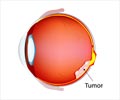New App named CRADLE surpasses the 'gold standard' of sensitivity in diagnosing the pediatric cancer Retinoblastoma, Baylor University researchers say.

‘CRADLE app detects Retinoblastoma at an early stage. It detects even the traces of leukocoria that appear as a 'gray' pupil which are difficult to detect with the naked eye.’
Read More..




The study, published in the journal Science Advances, found the app is an effective tool to augment clinical leukocoria screenings, allowing parents to efficiently and effectively screen their children more often throughout their development. Read More..
CRADLE -- developed by Baylor University researchers Bryan F. Shaw, Ph.D., professor of chemistry and biochemistry, along with Greg Hamerly, Ph.D., associate professor of computer science -- searches through family photographs for signs of leukocoria.
According to the study’s first author, Baylor senior University Scholar Micheal Munson, researchers determined the sensitivity, specificity and accuracy of the prototype by analyzing more than 50,000 photographs of children taken prior to their diagnosis.
For children with diagnosed eye disorders, CRADLE was able to detect leukocoria for 80 percent of the children. The app detected leukocoria in photos that were taken on average of 1.3 years prior to their official diagnosis.
The effectiveness of traditional screenings during a general physical exam is limited, with signs of retinoblastoma via the detection of leukocoria in only 8 percent of cases. CRADLE’s sensitivity for children age 2 and younger surpassed 80 percent. That 80 percent threshold is regarded by ophthalmologists as the ’’gold standard" of sensitivity for similar devices, Munson said.
Advertisement
As the app’s algorithm has become more sophisticated, its ability to detect even slight instances of leukocoria has improved.
Advertisement
Initially, the CRADLE app was used primarily to identify retinoblastoma -- a rare eye disease that is the most common form of eye cancer in children up to age 5. Shaw’s own experience as a parent of a child with retinoblastoma formed the genesis of the app.
Shaw and Hamerly created the app in 2014 for the iPhone and in 2015 for Android devices after Shaw’s son Noah lost his right eye, but his left eye was able to be salvaged. He is now 11.
"We suspected that the app would detect leukocoria associated with other more common disorders and some rare ones," Shaw said. "We were right. So far parents, and some doctors, have used it to detect cataract, myelin retinal nerve fiber layer, refractive error, Coats’ disease, and of course retinoblastoma."
Said Munson: "I just kept the goal in mind: saving the sight and potentially the lives of children throughout the world."
Shaw said they are retraining the algorithm with Baylor undergraduates currently tagging and sorting about 100,000 additional photos. He said they also are looking at additional features to cut down on false positive detections.
The app can be downloaded for free and can be found under the name "White Eye Detector."
Source-Eurekalert










